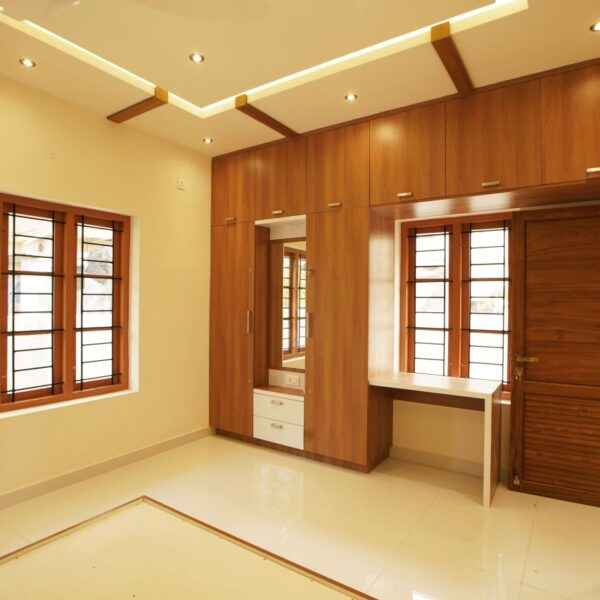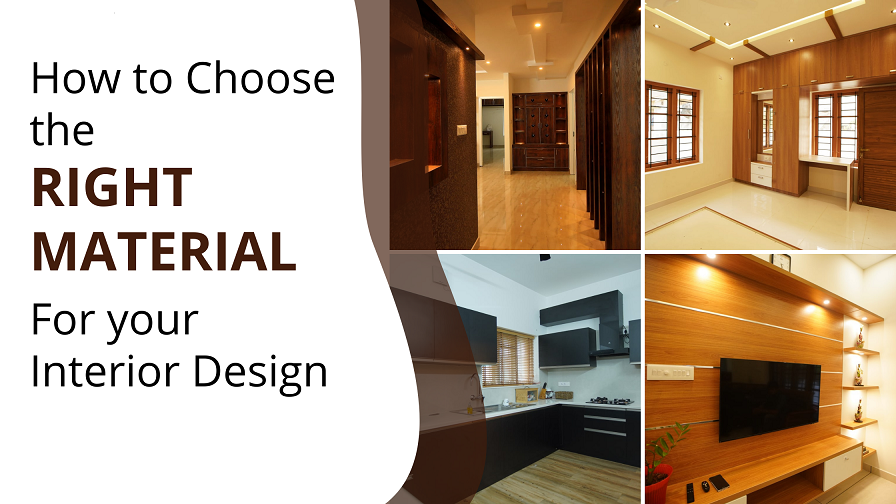Materials for Interior design
The choice of materials used for your interiors is a key factor that can make or break the looks of your dream home. Several materials can be used for interior design, depending upon the space in which they are used. The choice of other finishing products used in the room like floor tiles, paints, furnishing etc play an important role in choosing the right material for your interiors.
When doing interiors for kitchens and bathrooms, moisture resistant materials is a must. The wrong choice of material will ruin your project and you will end up paying more for fixing the errors.
A wide range of products are now available in the market that fits your taste and budget range. In this article, let’s have a look at some of the commonly used materials for interior design.
Plywood
Plywood – one of the most popular materials for interior design – is a kind of manufactured or engineered wood, made by sticking together pieces of wood, called veneer.
Depending upon the number of layers of veneer, plywood can be broadly classified – three-ply, five-ply and multi-ply. Ply refers to the number of layers of wood in the board and ultimately determines the thickness and strength of the board. The most used variant is the three-ply board. The veneer in the plywood itself can be of varied thicknesses. Therefore, the thickness of the boards of the same ply may differ from each other. Plywood is available in several thicknesses like 6mm, 8mm, 10mm, 12mm, 16mm, 18mm and 19mm, depending on the brand.
The IS grade of plywood in India is IS710. Let’s now look at the different grades of plywood available.
-
Plywood 710 grade
This is the most popular and by far the best grade of plywood available. Water resistant option of this plywood is the Marine plywood grade 710. Since plywood is made by sticking together pieces of wood, it’s quality depends on the type of wood used. Full gurjan plywood made from gurjan wood is the best as far as quality, durability and moisture resistance are concerned. However, Gurjan plywood is the most expensive option as well.
-
Plywood 303 grade
The next grade of plywood is the 303 grade plywood. The composition of wood particles in this grade is lower than the 710 grade. 303 gurjan options are also available. The quality, wood density and weight of the 303 grade plywood is lower than the 710 grade plywood. Just as in the 710 grade plywood, water resistant Marine plywood is available in grade 303 also.
Quality Test for Plywood
The plywood manufacturers subjects the plywood to several tests based on Indian Standards, to evaluate its physical and mechanical properties and to ascertain its fitness for use. Here are some of the most common techniques used to evaluate the quality of plywood.
This test is used to test the density of the plywood, which in turn depends on the timber used. The specimen is dried in an oven at high temperature until a constant mass is obtained.
BWP (Boiling Water Point grade) is a mechanism used to ascertain the moisture resistance of plywood. This is determined by how the plywood reacts when it comes in contact with boiling water. From the plywood boards specimens measuring at least 250mm x 250 mm are cut out and placed in boiling water for a specified period. These pieces are then cooled by plunging them in cold water. These wet pieces are then tested according to methods laid down by IS Standards.
This test is used to determine the tenacity with which the glue or binding material holds the veneers together. A similar test is used to determine how well the binding material holds the adjacent plies together.
Flammability test, Flame penetration test and Rate of burning tests are used to evaluate the fire resistance of the plywood.
Multiwood
Multiwood is a synthetic material used for interior design, manufactured by combining wood particles, resins etc. It mostly comes in white colour. Like plywood, multiwood is also available in thicknesses ranging from 6mm to 18 mm. Multiwood is made of waterproof material. It is very strong and durable.
An issue with using multiwood is that, since there are no fine wood particles, the boards cannot be screwed together. Fissures or plugs should be used to hold the boards together.
HDHMR
Next we look at the high density, high moisture resistant (HDHMR) material. Like the multiwood options, the HDHMR are also manufactured particle boards. They usually come pre-laminated with a standard set of pre-pressed laminates. If you wish to use the laminates of your choice in the HDHMR material, you will first need to make scratches on the pre-laminated boards and then glue the desired laminates on to it.
There is another variant in which the particle density is not as high as in the HDHMR boards. They are known as the HMR (High Moisture Resistant) Boards.
If you are looking for a low cost alternative for HDHMR, HDF (High Density Fibre) Boards and MDF (Medium Density Fibre) boards are good options. However, if you plan to use these materials for your interior design, make sure that they are not used in moisture prone areas. Long term exposure to moisture will cause the HDF and MDF boards to bulge.
The above-mentioned options HDHMR, HMR, MDF and HDF come in prelaminated boards. i.e. predesigned laminates would be pre-pressed on the boards. This makes these boards a very cost-effective material for interior design compared to plywood and multiwood, as you wouldn’t need to spend additional money on fixing the laminates.
Materials for Interior Design – Recap
| Plywood | Multiwood | HDHMR/HMR | MDF/HDF |
| Available in thicknesses 6mm – 19 mm | *Available in thicknesses 6mm – 19 mm | Available in thicknesses 6mm – 19 mm | Available in thicknesses 6mm – 19 mm |
| Need to fix laminates on top of the board, which would mean additional costs. | *Need to fix laminates on top of the board, which would mean additional costs. | Comes prelaminated with available laminates, thereby reducing costs | Comes prelaminated with available laminates, thereby reducing costs |
| Moisture resistant options are also available | *Moisture resistant | Highly Moisture resistant | Not moisture resistant and should not be used for moisture prone areas. |
| Not lightweight | *Not lightweight | Not lightweight | Lightweight |
| Strong and Durable | *Strong and Durable | Strong and Durable | Strong and Durable |
| Used for TV Unit, shelves, bedrooms wardrobes, washbasin counters, partitions, kitchen units, Beds, Cots, Tables | *Used for TV Unit, shelves, bedrooms wardrobes, washbasin counters, partitions, kitchen units | Used for TV Unit, shelves, bedrooms wardrobes, washbasin counters, partitions, kitchen units, Sliding doors | Used for TV Unit, shelves, bedrooms wardrobes, partitions |
Some of Viya’s interior works

How does Viya design your interiors?
First of all, our Interior design team would visit your site, study your requirements and take all the required measurements. Based on the requirements, our design team would come up with a design drawing detailing the number of partitions, doors etc. A cutting list is then prepared based on this drawing. This is done to determine the number and size of the pieces of plywood or other material that is required to make the design.
The setting of the boards can be done either manually or can be made as units that are assembled at site.
Manual Setting
The interior design material is then cut into the desired sizes, joined and screwed together to form boxes. Laminates are then glued on to these boards. The designer laminates are usually applied on the outside faces of the cupboards. White laminates are used on the insides of the cupboards as they are less expensive than the designer ones. The edges, especially the front facing ones are also laminated using similar materials.
The shutters and doors are then made and fixed using hinges. These days soft close or one touch hinges are a hot favourite for their ease of use. Sliders for drawers are then fixed. Sliders also come in soft close options. Finally handles are fixed.
Machine Setting
The entire process mentioned above can be done with minimal manual intervention too. In this process, majority of the activity happens at the design unit. The laminate is then machine pressed using a cool press machine and glued on to the board. Then in a panel saw machine the boards are cut into the sizes as defined by the cutting list. The edges are then laminated in an edge bind machine.
The boards are then transported to the site and assembled.
The advantage of using an automated setting is that the end product is of a higher quality and finish when compared to the manual setting.
Mini fix
As we saw in the automated setting, the boards are cut into desired sizes. Multi drilling machines are used to make holes that are suitable for mini fix screws. The boards are then transported to the site.
Mini fix screws are then screwed in to these holes and fixed in place.
